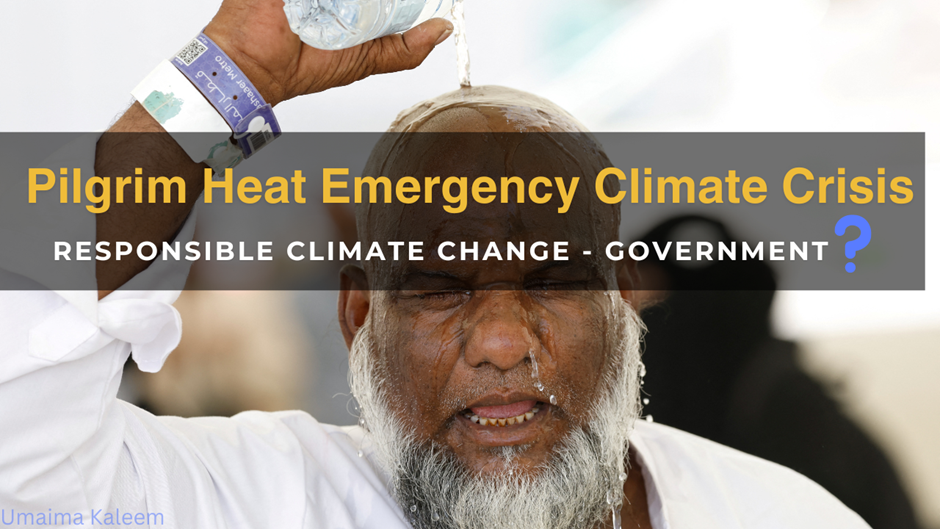
Umaima Kaleem
Devastating Heatwave Claims Lives in Saudi Arabia Amid Hajj Pilgrimage
Most Read Stories Today
-
Water Scarcity and Artificial Rainfall: The Positive and The Negative Effects of Cloud Seeding, including Health Hazards and Climate Implications.
-
Renewable Energy in Rural Areas: Challenges, Opportunities, and Successful Rural Projects
-
Pakistan's Agriculture at Risk Due to Climate Variability
-
South Africa's Recent Floods: Is Climate Change to Blame?
-
South Korea's floods: root causes and prevention strategies.
-
South Africa: Cape Town, A City Under Fire
-
The Human Cost of Climate Disasters
-
Our Oceans, Our Future: The South African Dilemma of Overfishing
-
Degenerative Impact of Hydrocarbons On The Environment.
-
Sustainable Urban Planning - Copenhagen and the Path to Climate Resilience
On the final day of a record-breaking heatwave in Saudi Arabia, the country was gripped by tragedy as extreme temperatures reached 50 degrees Celsius (122 degrees Fahrenheit), resulting in the deaths of numerous individuals.
This unprecedented heat has particularly affected the annual Hajj pilgrimage, where at least 900 people have succumbed to heatstroke, highlighting the deadly intersection of climate change and large-scale human gatherings.
Unprecedented Temperatures
Saudi Arabia, known for its arid desert climate, has always faced extreme heat during the summer months. However, the recent spike in temperatures has been unparalleled, with the mercury soaring to 50°C. This heatwave has been attributed to the broader impacts of climate change, which has led to more frequent and severe weather extremes across the globe. The combination of high temperatures, low humidity, and intense solar radiation created a perilous environment for anyone exposed to the elements for extended periods.
The Hajj Pilgrimage Under Threat
The Hajj pilgrimage, one of the five pillars of Islam, draws millions of Muslims to Mecca annually. This year, over two million pilgrims converged in Saudi Arabia to perform the religious rites. Despite extensive preparations and safety measures by the Saudi government, the extreme heat posed insurmountable challenges.
Heatstroke occurs when the body can no longer regulate its temperature, leading to symptoms such as confusion, seizures, and loss of consciousness. With temperatures soaring and limited shade available, pilgrims found themselves at great risk. Emergency services were overwhelmed as the number of heat-related incidents skyrocketed.
Climate Change and Its Role
The sweltering conditions in Saudi Arabia are a stark reminder of the escalating impact of climate change. Rising global temperatures are linked to increased greenhouse gas emissions, primarily from burning fossil fuels and deforestation. As global temperatures rise, heatwaves become more intense and frequent, posing significant health risks, particularly in already hot regions like the Middle East.
According to climate scientists, the likelihood of such extreme temperatures occurring is significantly higher due to human-induced climate change. The Intergovernmental Panel on Climate Change (IPCC) has warned that without substantial reductions in greenhouse gas emissions, the frequency and severity of heatwaves will continue to rise, endangering lives and livelihoods worldwide.
Government Response and Future Measures
In response to the crisis, the Saudi government has launched an extensive emergency response effort. This includes deploying additional medical personnel, establishing cooling stations, and providing ample supplies of water to affected areas. Despite these measures, the sheer scale of the heatwave and the number of pilgrims involved have made it challenging to mitigate the impact fully.
Looking ahead, there is an urgent need for long-term strategies to address the root causes of climate change and to enhance resilience against extreme weather events. For Saudi Arabia, this means not only continuing its efforts to improve the safety of the Hajj pilgrimage but also committing to broader environmental policies that reduce carbon emissions and promote sustainable development.
Conclusion
The tragic loss of life due to the extreme heatwave in Saudi Arabia underscores the immediate and profound impacts of climate change. As the world faces a future with more frequent and severe weather events, it is imperative that global leaders and communities take decisive action to mitigate climate change and protect vulnerable populations. The Hajj pilgrimage, a sacred and cherished tradition, must be safeguarded against the growing threats posed by our changing climate.

Terms & Conditions
Subscribe
Report
My comments